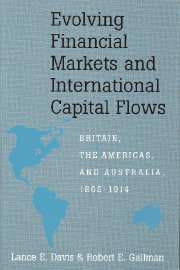 Evolving Financial Markets and International Capital Flows
Evolving Financial Markets and International Capital Flows Book contents
- Frontmatter
- Contents
- 1 Institutional invention and innovation: Foreign capital transfers and the evolution of the domestic capital markets in four frontier countries: Argentina, Australia, Canada, and the United States, 1865–1914
- 2 The United Kingdom
- 3 International capital movements, domestic capital markets, and American economic growth, 1865–1914
- 4 Domestic savings, international capital flows, and the evolution of domestic capital markets: The Canadian experience
- 5 Domestic saving, international capital flows, and the evolution of domestic capital markets: The Australian experience
- 6 Argentine savings, investment, and economic growth before World War I
- 7 Lessons from the past: International financial flows and the evolution of capital markets, Britain and Argentina, Australia, Canada, and the United States before World War I
- 8 Skipping ahead: The evolution of the world's finance markets 1914–1990 – A brief sketch
- 9 Lessons from the past
- Bibliography
- Index
5 - Domestic saving, international capital flows, and the evolution of domestic capital markets: The Australian experience
Published online by Cambridge University Press: 18 August 2009
- Frontmatter
- Contents
- 1 Institutional invention and innovation: Foreign capital transfers and the evolution of the domestic capital markets in four frontier countries: Argentina, Australia, Canada, and the United States, 1865–1914
- 2 The United Kingdom
- 3 International capital movements, domestic capital markets, and American economic growth, 1865–1914
- 4 Domestic savings, international capital flows, and the evolution of domestic capital markets: The Canadian experience
- 5 Domestic saving, international capital flows, and the evolution of domestic capital markets: The Australian experience
- 6 Argentine savings, investment, and economic growth before World War I
- 7 Lessons from the past: International financial flows and the evolution of capital markets, Britain and Argentina, Australia, Canada, and the United States before World War I
- 8 Skipping ahead: The evolution of the world's finance markets 1914–1990 – A brief sketch
- 9 Lessons from the past
- Bibliography
- Index
Summary
Introduction
The Australian experience stands in marked contrast to those of Canada and the United States. Although all three were frontier countries, initially Australia had by far the smallest population, and, therefore, population growth over the next half century depended relatively more on immigration. In 1865 the population of the six colonies was less than 1.4 million. In contrast, the Canadian population was 3.4 million, and that of the United States, 35.7 million. Over the next five decades Canadian population grew at an annual rate of 1.7 percent, that of the United States at 2.0 percent, but that of Australia at 2.5 percent.
Initially, Australian income had been raised by the gold and silver discoveries of the 1850s, but gold can be taken out of the ground only once. Between 1860 and the Western Australian discoveries of the late 1880s, precious metal production played a steadily decreasing role in the continent's economic expansion. Given the initial high levels of income and the subsequent exhaustion of the mines, except for the fifteen years from 1889 to 1904, Australia's economic performance was remarkably good. Between 1861 and 1889, when population was increasing by 3.5 percent a year, per capita real GDP rose by 1.3 percent per year; and between 1905 and 1914, when the rate of population increase was 2.3 percent, real per capita GDP was increasing by 2.9 percent (see Table 5:1-1).
- Type
- Chapter
- Information
- Evolving Financial Markets and International Capital FlowsBritain, the Americas, and Australia, 1865–1914, pp. 471 - 643Publisher: Cambridge University PressPrint publication year: 2001
- 1
- Cited by


